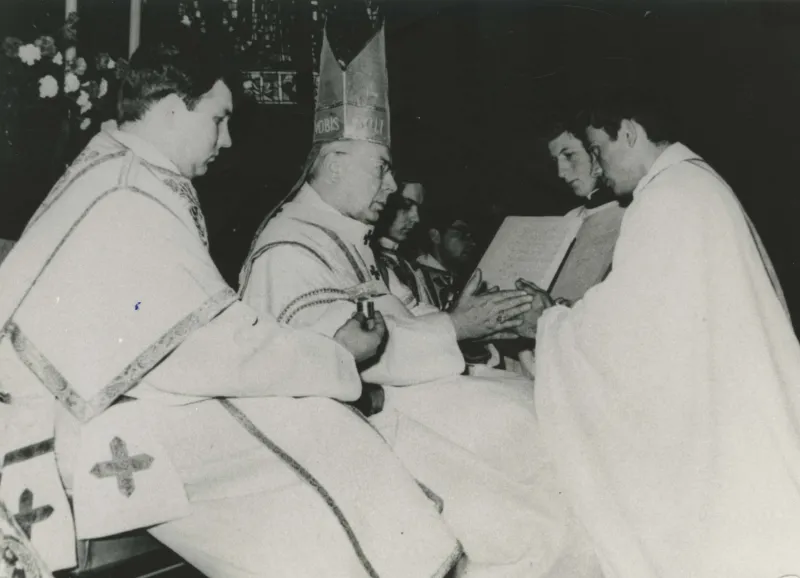
London, England, May 28, 2022 / 04:00 am (CNA).
Fifty years ago, the lives of two heroic Polish Catholics crossed at St. John’s Archcathedral in Warsaw’s Old Town.
A photograph from that day — May 28, 1972 — shows Cardinal Stefan Wyszyński clasping the hands of Jerzy Popiełuszko between his own during the 24-year-old’s ordination to the priesthood.
Today, both men are blesseds and their portraits can be seen in churches throughout Poland.
Great suffering lay ahead of them, but that spring day was joyful. Wyszyński ordained a total of 31 new priests: an impressive number given the hardships that Poland’s Catholics suffered under a communist regime that sought to stifle the Church.
The cardinal spoke only briefly at the ordination ceremony. In his address, preserved by the Instytut Prymasowski Stefana Kardynała Wyszyńskiego, he told the new priests that they were being sent out to serve the People of God in the Name of the Father, Son, and Holy Spirit.
“We prayed,” Wyszyński said, “to the Holy Spirit to strengthen this work in them, so that the new priests would confess God’s truth bravely, in their words and in their lives, before the People of God.”
Father Jerzy Popiełuszko did indeed “confess God’s truth bravely” — and paid for it with his life.

After the communist authorities declared martial law in 1981, he celebrated monthly “Masses for the Homeland” at his church in Warsaw’s Żoliborz district. Thousands of people attended and his defiant homilies were broadcast on Radio Free Europe.
In 1982, the priest’s home was bombed. A year later, he was arrested on false charges, but released after a public outcry. The year after that, he evaded a “traffic accident” designed to kill him.
But on Oct. 19, 1984, the authorities finally caught up with him. He was driving back to Warsaw after celebrating Mass in Bydgoszcz when three Security Service agents waved to him to pull over, pretending that their vehicle had broken down.
They are said to have beaten him with a rock until he died, and then tied weights to his body and flung it into a reservoir.
His remains were recovered on Oct. 30, generating a wave of revulsion that undermined what little was left of the regime’s legitimacy.
Popiełuszko was beatified on June 6, 2010, years before the man who ordained him was declared blessed.
Cardinal Wyszyński led the Polish Church during some of the most challenging times of the communist era. He was placed under house arrest in 1953 for three years after he refused to subordinate the Church to the state.
Today we celebrate for the first time the liturgical memory of Blessed Cardinal Stefan Wyszyński, Primate of the Millennium, beatified on 12 September last year in Warsaw.
Bl. Stefan Wyszyński, pray for us! pic.twitter.com/6dElwH2Jc3
— Church in Poland (@ChurchInPoland) May 28, 2022
He is known today as the “Primate of the Millennium” because as Primate of Poland he oversaw a nine-year program of preparation culminating in a nationwide celebration of the millennium of Poland’s baptism in 1966.
He also helped to secure the approval of Karol Wojtyła as archbishop of Kraków in 1964, which ultimately led to Wojtyła’s election as Pope John Paul II in 1978.
Wyszyński died in 1981 of abdominal cancer, perhaps mercifully not living to see the fate of the young man he ordained to priesthood.
Wyszyński was beatified on Sept. 12, 2021. His liturgical memorial is celebrated for the first time on May 28. The day is not only the anniversary of his death, but also of the ordination of Father Popiełuszko.
Justyna Galant in Warsaw contributed to this article.
If you value the news and views Catholic World Report provides, please consider donating to support our efforts. Your contribution will help us continue to make CWR available to all readers worldwide for free, without a subscription. Thank you for your generosity!
Click here for more information on donating to CWR. Click here to sign up for our newsletter.




Leave a Reply